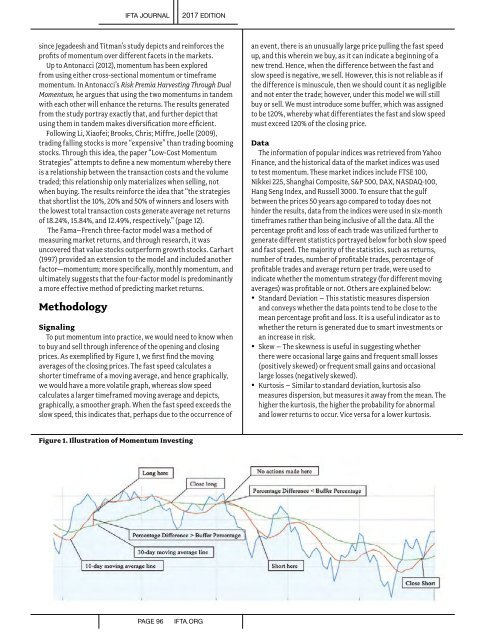Create successful ePaper yourself
Turn your PDF publications into a flip-book with our unique Google optimized e-Paper software.
IFTA JOURNAL<br />
2017 EDITION<br />
since Jegadeesh and Titman’s study depicts and reinforces the<br />
profits of momentum over different facets in the markets.<br />
Up to Antonacci (2012), momentum has been explored<br />
from using either cross-sectional momentum or timeframe<br />
momentum. In Antonacci’s Risk Premia Harvesting Through Dual<br />
Momentum, he argues that using the two momentums in tandem<br />
with each other will enhance the returns. The results generated<br />
from the study portray exactly that, and further depict that<br />
using them in tandem makes diversification more efficient.<br />
Following Li, Xiaofei; Brooks, Chris; Miffre, Joelle (2009),<br />
trading falling stocks is more “expensive” than trading booming<br />
stocks. Through this idea, the paper “Low-Cost Momentum<br />
Strategies” attempts to define a new momentum whereby there<br />
is a relationship between the transaction costs and the volume<br />
traded; this relationship only materializes when selling, not<br />
when buying. The results reinforce the idea that “the strategies<br />
that shortlist the 10%, 20% and 50% of winners and losers with<br />
the lowest total transaction costs generate average net returns<br />
of 18.24%, 15.84%, and 12.49%, respectively.” (page 12).<br />
The Fama–French three-factor model was a method of<br />
measuring market returns, and through research, it was<br />
uncovered that value stocks outperform growth stocks. Carhart<br />
(1997) provided an extension to the model and included another<br />
factor—momentum; more specifically, monthly momentum, and<br />
ultimately suggests that the four-factor model is predominantly<br />
a more effective method of predicting market returns.<br />
Methodology<br />
Signaling<br />
To put momentum into practice, we would need to know when<br />
to buy and sell through inference of the opening and closing<br />
prices. As exemplified by Figure 1, we first find the moving<br />
averages of the closing prices. The fast speed calculates a<br />
shorter timeframe of a moving average, and hence graphically,<br />
we would have a more volatile graph, whereas slow speed<br />
calculates a larger timeframed moving average and depicts,<br />
graphically, a smoother graph. When the fast speed exceeds the<br />
slow speed, this indicates that, perhaps due to the occurrence of<br />
an event, there is an unusually large price pulling the fast speed<br />
up, and this wherein we buy, as it can indicate a beginning of a<br />
new trend. Hence, when the difference between the fast and<br />
slow speed is negative, we sell. However, this is not reliable as if<br />
the difference is minuscule, then we should count it as negligible<br />
and not enter the trade; however, under this model we will still<br />
buy or sell. We must introduce some buffer, which was assigned<br />
to be 120%, whereby what differentiates the fast and slow speed<br />
must exceed 120% of the closing price.<br />
Data<br />
The information of popular indices was retrieved from Yahoo<br />
Finance, and the historical data of the market indices was used<br />
to test momentum. These market indices include FTSE 100,<br />
Nikkei 225, Shanghai Composite, S&P 500, DAX, NASDAQ-100,<br />
Hang Seng Index, and Russell 3000. To ensure that the gulf<br />
between the prices 50 years ago compared to today does not<br />
hinder the results, data from the indices were used in six-month<br />
timeframes rather than being inclusive of all the data. All the<br />
percentage profit and loss of each trade was utilized further to<br />
generate different statistics portrayed below for both slow speed<br />
and fast speed. The majority of the statistics, such as returns,<br />
number of trades, number of profitable trades, percentage of<br />
profitable trades and average return per trade, were used to<br />
indicate whether the momentum strategy (for different moving<br />
averages) was profitable or not. Others are explained below:<br />
• Standard Deviation – This statistic measures dispersion<br />
and conveys whether the data points tend to be close to the<br />
mean percentage profit and loss. It is a useful indicator as to<br />
whether the return is generated due to smart investments or<br />
an increase in risk.<br />
• Skew – The skewness is useful in suggesting whether<br />
there were occasional large gains and frequent small losses<br />
(positively skewed) or frequent small gains and occasional<br />
large losses (negatively skewed).<br />
• Kurtosis – Similar to standard deviation, kurtosis also<br />
measures dispersion, but measures it away from the mean. The<br />
higher the kurtosis, the higher the probability for abnormal<br />
and lower returns to occur. Vice versa for a lower kurtosis.<br />
Figure 1. Illustration of Momentum Investing<br />
PAGE 96<br />
IFTA.ORG


